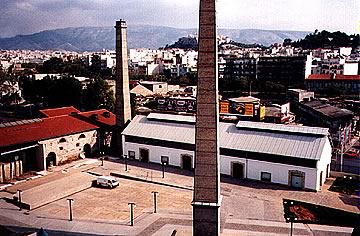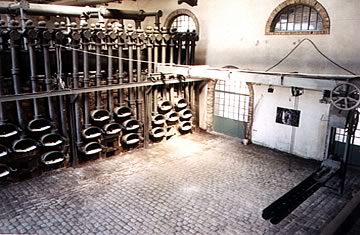
"Technopolis"
Formerly the old gasworks. Renovation and transformation into a cultural centre.
Pireos St, 1988-
Architects:
Municipality of Athens Architectural Centre.
With the collaboration of many architects and other professionals.
The Gas Company factory was built on the main road linking Athens with Piraeus. Its presence marked the subsequent development of the surrounding district, which evolved into one of the industrial centres of the capital region.
The gasworks called "Gazi" was an independent unit whose exclusive concern was to ensure a regular supply of coal gas to light the city of Athens. The gas was produced on the site and supplied to the city’s network.
The buildings followed the Greek eclecticist style of the period, which was a type of early "industrial Romanticism".
When the gasworks first went into operation (1862), it contained the first core of the extraction furnaces with the first smoke stack, pumps for moving the gas, the pressure-regulating chamber, the two first gas holders, the coolers, the water tanks, the chambers for chemical and mechanical cleaning, the workshops on Pireos St, the oblong storage building and the two-storey manager’s residence.
In view of the Olympic Games in 1896, the city lighting was extended and the gasworks were enlarged during a second phase that lasted until around 1920. During this phase, the factory took on more or less its final form.
The third phase (1920-50) was characterised by the introduction of German technology and the quantitative growth of production. The morphological changes made by the Germans were in the constructivist style. Thus the gasworks buildings represent various styles in the history of industrial architecture. The most substantial development took place in 1983 when the production of coal gas ceased definitively.
Then the gasworks were designated a heritage industrial site and indeed unique of their kind in Europe. In 1988 the Municipality of Athens began the process of converting the site. The first works concerned the restoration of the site to its initial state through the demolition of unnecessary walls and buildings so that what remained were the buildings that presented architectural and functional interest. The project was undertaken by architects from the Municipality of Athens as well as external associate architects who submitted their proposals to the architectural competitions and received awards.
It should be emphasised that the location of the gasworks alongside the archaeological site of Keramikos and the Sacred Way and near the neoclassical centre of Athens, the ancient Agora and the traditional districts of the city lent them a particular weight as a landmark.
Today the site of the old gasworks has gradually taken on a new form. It has been transformed into a hive of cultural activities. The aesthetic of the industrial revolution has lent its shell to new functions. It is called Technopolis, a place for multiple cultural uses, a Municipality of Athens project. Technopolis, a modern cultural and technological showroom, operates on three levels, as a cultural venue, and as a place for demonstrating advanced science and for promoting new technologies.
TRANSPORTATION

